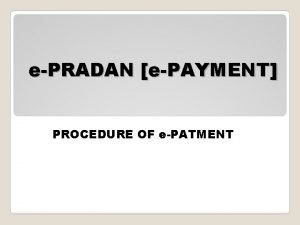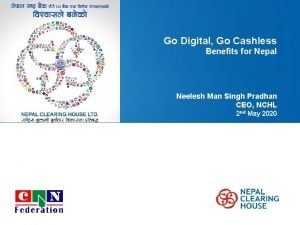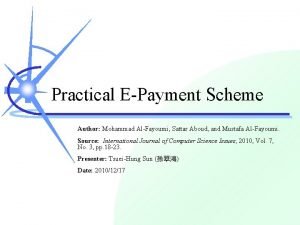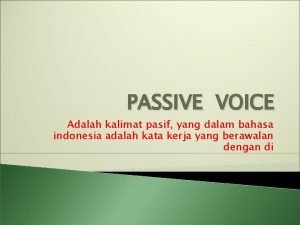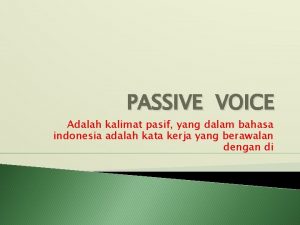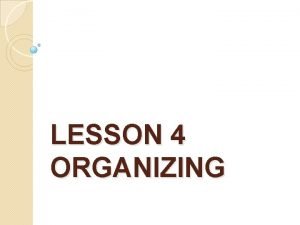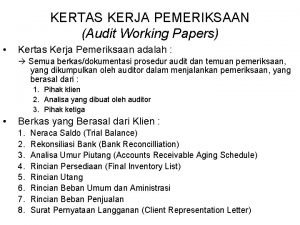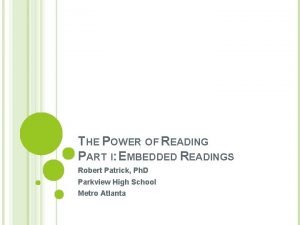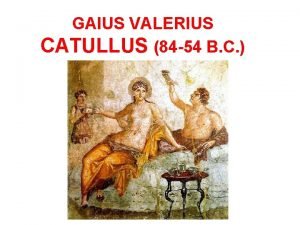Next Week update to schedule per icegate MondayTuesday
































- Slides: 32

Next Week (update to schedule per ‘ice-gate’) • Monday/Tuesday • Period 6 TEST!! (insert party emoji here) • Wednesday/Thursday • Introduction to the APUSH DBQ (insert TWO party emojis here!) • Friday • Intro to Progressives – Four Corners Activity • Socratic readings assignments distributed, Due for Socratic on Monday College Credit Information: • Baker spring enrollment is now live on the BVW Counseling Website – due 1/29 • AP Test enrollment will be presented by Mr. Sone to each AP class in a few weeks


Gilded Age: Day 6 Politics and Minorities

In the Gilded Age, presidents were seen as less powerful than monopolists like Carnegie, JP Morgan, and Rockefeller

Grant was the most important president of the era, but his administration was plagued by scandals The worst scandal was Crédit Mobilier which involved bribes by railroad companies to gain lands grants Whiskey Ring involved companies bribing government officials to avoid paying taxes

Politics of the Gilded Age • Seemingly healthy – high turnout for elections, elections closely contested, lots of political rally’s, • However, government was too small for such rapid growth of business and population • Stalemate in Congress/White House on various issues • Aforementioned scandals • North controlled by Republicans – supported high protective tariff • South and West controlled by Democrats • Party leaders/organizers had close ties to big business 1868 - Grant (x 2) 1876 – Rutherford B Hays 1880 James Garfield 1884 Grover Cleveland 1888 –Benjamin Harrison 1892 – Grover Cleveland 1896 – Mc. Kinley (x 2)

Farmers in Protest After the Civil War farming expanded and as more land was cultivated supplies grew faster than demand which caused prices to fall while the farmers costs of transporting their goods to market, for seed, and for equipment all rose. HOMESTEAD ACT – Farmers up to 160 acres for improving land MORRELL ACT – State land grant colleges Farmers blamed their troubles on three groups: 1. Railroads, because they engaged in pools and rebates. 2. Eastern manufacturers because they charged high prices for their products. 3. Bankers because of their lending practices and a money supply based on gold.

Could there be a better way? 3 rd party and Populism • History of Populists: • Previously Farmers Alliance • Before that, Grange movements • Populists encompassed many ideas (see cartoon) but a theme was the representation of working, usually western, people who felt the system was rigged to serve the wealthy and big business • Complete Populism and 3 rd party worksheets

Election of 1892 Summarize the impact of the Populist party on the election of 1892.

Populism Peaks and Declines • 1892 – biggest showing on their own in a presidential election • Panic of 1893 Causes a severe depression; laborers and farmers call for various changes, like bi-metallism. • 3 million out of work, 16, 000 businesses and 500 banks close…and the government continues laissez faire capitalism! • 1896 – throw support behind the Democratic nominee – William Jennings Bryan • Realize they don’t have a legitimate shot on their own • 1900 – pretty much extinct • • • The economy experienced rapid change. The era of small producers and farmers was fading away. Race divided the Populist Party, especially in the South. The Populists were not able to break existing party loyalties. Most of their agenda was co-opted by the Democratic Party.

Bi-Metallism • A monetary standard in which the value of the unit is defined as equivalent both to a certain quantity of gold and to a certain quantity of silver; • Establishes a fixed rate of exchange between the two metals.

Populists in 1896 support Democrat William Jennings • He supports the same Bryan things as the populists • You shall not press down upon the brow of labor this crown of thorns; you shall not crucify mankind upon a cross of gold! Revivalist Style Oratory Skills • Bi-Metallism The Cross of Gold Speech 18, 000 miles of campaign “whistle stops. ”

But…neither win. Enter Republican William Mc. Kinley • Civil War Vet • Lawyer • Crazy Successful • Congressman • Governor of Ohio • More on him in period 7

Solid vs. Gilded? ? Attempted fixes: Reforms • Pendleton Civil Service Act of 1883 – • To combat patronage, merit based system for federal employees with appointment to jobs via competitive examinations (not political influence) • Interstate Commerce Commission (ICC) 1887 – • Mandated ‘reasonable’ rates for farmers from Railroads. First federal agency to regulate economic activity, but couldn’t set rates, would have to sue RR companies (therefore little impact) • Sherman Antitrust Act – 1890 • Banned combinations and practices that restrained free trade, but so vague it was almost impossible to enforce • Overall weak laws, but a start.

Separate but Equal Framework: Increasingly prominent racist and nativist theories, along with Supreme Court Decisions such as Plessey v. Ferguson, were used to justify white violence as well as local and national policies of discrimination and segregation. Framework: Challenging their prescribed “place, ” women and African American activists articulated alternative visions of political, social, and economic unity.

Jim Crow Laws 1876 -1965 • Between 1890 and 1910, ten of the eleven former Confederate states, starting with Mississippi, passed new constitutions or amendments that effectively disfranchised most blacks and tens of thousands of poor whites through a combination of poll taxes, literacy and residency/recordkeeping requirements. • Grandfather Clause • Facilities • Separate

Challenging Jim Crow • Plessy v. Ferguson (1896), is a landmark United States Supreme Court decision in the jurisprudence of the United States, upholding the constitutionality of state laws requiring racial segregation in public facilities under the doctrine of "separate but equal. "

The Set Up • LA had passed the Separate Car Act saying any RR in LA must provide separate but equal rail cars for both black and white people. The penalty for a black person sitting in the all white passenger car was $25 or 20 days in jail. • A group of African Americans united in a group to challenge the LA call. They called themselves the Citizens' Committee to Test the Constitutionality of the Separate Car Act. They found a white lawyer to try the case pro bono and joined with the East LA Railroad Company who wanted to get rid of the law for financial reasons. • The group raised $3000 for this issue • The group elect Homer Plessy to execute their plan. He purchased a first class ticket, sat in the white car, and was quickly arrested by RR officials all according to plan. • Two lower courts sided with the state of LA. Plessy and the group took their case all the way to the Supreme Court.

This is Homer Plessy

Plessey vs. Ferguson • Homer Plessy, the plaintiff in the case, was seven-eighths white and one-eighth black, and had the appearance of a white man. On June 7, 1892, he purchased a first-class ticket for a trip between New Orleans and Covington, La. , and took possession of a vacant seat in a white-only car where he was later arrested and imprisoned. • Plessy was brought to trial and found guilty. He would sue the judge of the trial, Hon. John H. Ferguson, at the Louisiana Supreme Court, arguing that the segregation law violated the Equal Protection Clause of the Fourteenth Amendment, which forbids states from denying "to any person within their jurisdiction the equal protection of the laws, " as well as the Thirteenth Amendment, which banned slavery.

Plessey Decision • Supreme Court Decisions: 7 -1 (one of the justices did not participate – his daughter died) • Majority Decision • Dissenting Opinioin (No Concurring Opinions) • Read majority and minority excerpts

Lasting Impacts of Plessy Decision

Other African Americans challenge their position in society Two approaches: Booker T Washington Accept temporary discrimination Find a labor skill and work hard We will eventually earn respect of white individuals W. E. B. Du. Bois (more in period 7) Discrimination is unacceptable Helped to found the NAACP Plan for the ‘talented tenth’ college educated group to lead other African Americans

Booker T. Washington’s Atlanta Compromise Speech A ship lost at sea for many days suddenly sighted a friendly vessel. From the mast of the unfortunate vessel was seen a signal: “Water, water. We die of thirst. ” The answer from the friendly vessel at once came back: “Cast down your bucket where you are. ” A second time, the signal, “Water, send us water!” went up from the distressed vessel. And was answered: “Cast down your bucket where you are. ” A third and fourth signal for water was answered: “Cast down your bucket where you are. ” The captain of the distressed vessel, at last heeding the injunction, cast down his bucket and it came up full of fresh, sparkling water from the mouth of the Amazon River. To those of my race who depend on bettering their condition in a foreign land, or who underestimate the importance of preservation friendly relations with the southern white man who is their next door neighbor, I would say: “Cast down your bucket where you are. ” Cast it down, making friends in every manly way of the people of all races, by whom you are surrounded. • Washington argued that the surest way for blacks to gain equal social rights was to demonstrate "industry, thrift, intelligence and property. “ https: //www. youtube. com/watc • This was known as the “go slow” approach.

Women’s Movement Continues • Two Approaches to Women’s Suffrage • 1869 – two different women’s groups are formed to attempt to get women the right to vote • National Women’s Suffrage Association – wants an amendment • American Women’s Suffrage Association – wants individual states to allow suffrage • Dec 1869 – Wyoming is the first state to allow women the right to vote

Prostitution, Women, and Suffrage

Susan B Anthony • As a vocal leader of the NWSA, Susan B Anthony… • Wrote Pamphlets • Gave Speeches • Testified before Congress every year form 18691906 • Staged Protests • In 1872 Anthony and 3 sisters register to vote and vote in New York only to be arrested soon thereafter. • She used her trial as a platform to justify women’s rights. • She refused her $100 fine, but instead of being arrested creating more publicity the judge dropped the case.

Supreme Court Rules • 1875 - The Supreme Court rules that women ARE citizens, but citizenship does not guarantee the right to vote. Minor v Happerset • The Court passed the power to grant suffrage to the States.

States Allowing Suffrage

Anti-Suffrage Arguments • • Voting would interfere in women’s roles at home. Women were under educated and inexperienced. Most women don’t want to vote… right? Marriage is sacred, the man is the speaker, and suffrage would undermine the husband. This Image is not until later…closer to the 19 th Amendment ratification in 1919

Moving Forward • NWSA & AWSA merge in 1890 • Susan B Anthony dies in 1906, her final public statement was “Failure is impossible. ” • When women are granted the right to vote on the national stage, in 1920, only 1 attendee of the Seneca Falls Convention is alive. Charlotte Woodward was 92.

 X.next = x.next.next
X.next = x.next.next Alternative of log based recovery
Alternative of log based recovery Week by week plans for documenting children's development
Week by week plans for documenting children's development Icegate sbill status
Icegate sbill status Epradan
Epradan Drawback enquiry icegate
Drawback enquiry icegate Icegate epayment
Icegate epayment Icegate duty payment
Icegate duty payment Wpi student portal
Wpi student portal Icegate epayment
Icegate epayment Icegate epayment
Icegate epayment Kalimat pasif dari i write a letter
Kalimat pasif dari i write a letter Next week we are going to
Next week we are going to His landlord asked him to move
His landlord asked him to move Let's plan for next week
Let's plan for next week 40-hour work week schedule examples
40-hour work week schedule examples 40-hour work week schedule examples
40-hour work week schedule examples Pemilikan dan penyimpanan kertas kerja pemeriksaan
Pemilikan dan penyimpanan kertas kerja pemeriksaan A deli sells 640 sandwiches
A deli sells 640 sandwiches Il mio diletto
Il mio diletto 24 km/jam berapa dam/menit
24 km/jam berapa dam/menit Per capita vs per stirpes
Per capita vs per stirpes Semas jautis dangu laizo
Semas jautis dangu laizo Per stirpes v per capita
Per stirpes v per capita Moltiplicazioni con numeri periodici
Moltiplicazioni con numeri periodici 186 282 miles per second into meters per second
186 282 miles per second into meters per second Multas per gentes et multa per aequora vectus
Multas per gentes et multa per aequora vectus Multās per gentēs et multa per aequora vectus
Multās per gentēs et multa per aequora vectus Coop per me e per te
Coop per me e per te 1 hr = 60 min
1 hr = 60 min Longum iter est per praecepta breve per exempla
Longum iter est per praecepta breve per exempla Borg e
Borg e Adobe connect update
Adobe connect update




